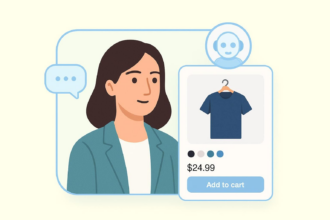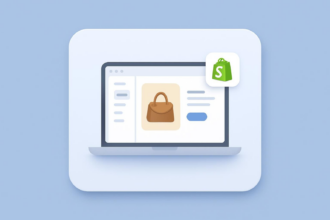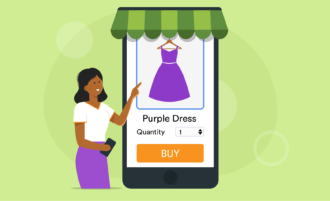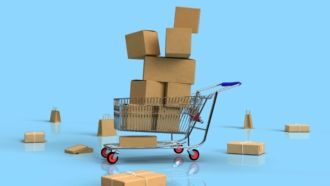Tips to sell on Shopify without inventory
- Dropshipping
- Print on demand
- Third-party fulfillment centers
- Multilevel marketing
- Affiliate marketing
Shopify provides business owners with a great opportunity to sell their products online. However, maintaining inventory and ensuring you always have everything you need on hand can be challenging. Some businesses don’t have the capital to buy or build up inventory, while others don’t have the storage space for it. Still others don’t want to deal with the logistics of packing, shipping, and delivering products.
Even if you don’t want to hold inventory, you can still build a successful company using an alternative business model. So how do you sell on Shopify without inventory? We’ve summarized a few options below.
Do you need inventory for Shopify?
No, you don’t need to maintain physical inventory to run a successful Shopify store. Shopify supports a variety of business models that allow you to sell products without handling or storing them yourself. These include dropshipping, print-on-demand, third-party logistics (3PL), multi-level marketing (MLM), and affiliate marketing. This flexibility makes Shopify an ideal platform for entrepreneurs who want to start a business with low upfront investment and minimal operational overhead.
Pro Tip
Shopify AI Agents deliver 24/7 support, personalized interactions, and real-time access to store data — all while helping you understand customer behavior and improve product recommendations.
For example, in a dropshipping model, products listed on your store are shipped directly to the customer by a third-party supplier. In print-on-demand, items like t-shirts, mugs, or posters are only produced and shipped when a customer orders. These approaches eliminate the need for inventory storage, reduce financial risk, and make e-commerce more accessible. With a wide range of app integrations, Shopify makes it easy to adopt these inventory-free models and streamline your online business.
How to sell on Shopify without inventory: 5 alternative business models
1. Dropshipping
One of the most popular ways to sell on Shopify without holding any inventory is through dropshipping.
Shopify stores that use this business model don’t need to have their own product inventory, warehouse, or shipping capabilities. Instead, they partner with a dropshipping company that performs these functions for them.
The Shopify store displays products for sale on its website, but the dropshipper is typically responsible for sourcing or manufacturing them. When a customer makes a purchase, the dropshipping company ships the order.
A Shopify retailer can also do its own sourcing through retail services companies such as AliExpress and SaleHoo, which connect it with wholesale suppliers. In either case, the Shopify merchant’s products need not be unique (though it certainly helps provide a unique value proposition if they are).
Regardless of which dropshipping partner you work with, it’s important to keep an eye on shipping costs. “Make sure you have proper shipping costs configured,” says Dan Doughty, founder of Dripshipper, a private-label coffee dropshipping business. “Every supplier handles this differently, and you can lose profitability if you don’t have proper shipping costs set up to charge your customers.”
2. Print on demand
A Shopify retailer can sell customized, design-focused products through the print-on-demand business model. Stationery, wedding invitations, photo books, mugs, T-shirts, and posters are typical examples of products suited to print on demand.
In this case, the Shopify store partners with a print-on-demand company that stores the basic products (such as blank paper, mugs, and shirts) and has the infrastructure to print custom designs on them. Customers order through the Shopify store, and the print-on-demand business fulfills the orders and ships to the customer. Apart from keeping a watchful eye on the customer experience, the Shopify merchant doesn’t need to worry about logistics.
3. Third-party fulfillment centers
In some ways, third-party fulfillment centers (also known as third-party logistics, or 3PL, centers) are similar to dropshippers.
Like dropshippers, these businesses hold inventory and handle packing, shipping, and delivery — but with the 3PL model, the Shopify business typically manufactures its own products and sends them to the third-party fulfillment center for storage and shipping. This gives the business greater flexibility and control over product design and quality, as well as possible cost savings through economies of scale.
“When starting a new store, dropshipping often provides a cheaper and less capital-intensive solution,” says Daniel Anderson, founder of The Money Maniac. “However, as the store grows and volume increases, buying in bulk and shipping with the negotiated rates of a 3PL can become more affordable. Plus, with a greater ability to manage inventory, shipping times, and packaging, 3PLs often provide a better customer experience.”
Many of the processes in both dropshipping and third-party fulfillment centers are automated, saving substantial amounts of time and money. Businesses can’t rely solely on automation to do the job, however, and must check on their automation settings frequently.
“Double-check at least once a week to make sure all orders were properly sent to the supplier,” says Doughty. “You want to be checking in on these things to ensure your customer doesn’t have a poor experience with your brand.”
4. Multilevel marketing
Another way to sell on Shopify without inventory is to join forces with a multilevel marketing (MLM) company.
MLM companies sell everything from makeup and Tupperware to jewelry, accessories, and a wide range of other products. As a Shopify store owner, you build the store site and sell the products that the MLM organization offers. The MLM holds all the inventory in its own warehouse, and you either pick up the products and ship them to customers yourself or have the MLM ship products directly to paying customers.
5. Affiliate marketing
Affiliate marketing is a popular and highly scalable method for selling products on Shopify without managing inventory or handling logistics. Under this model, Shopify store owners promote products or services from third-party companies through unique affiliate links. When visitors click on these affiliate links and make purchases from the external company’s site, the Shopify store owner earns a predetermined commission for each successful sale or referral.
The appeal of affiliate marketing lies in its simplicity and low barrier to entry. Shopify store owners do not need to invest in product creation, inventory storage, shipping, or even customer support, as these tasks are managed entirely by the affiliate company.
Affiliate marketing is particularly effective for content creators, bloggers, influencers, or those with a strong online presence. Merchants can effectively drive targeted traffic toward their affiliate partners by strategically placing affiliate links within engaging content such as blogs, product reviews, tutorials, or social media posts.
Shopify facilitates affiliate marketing by seamlessly integrating with various dedicated affiliate marketing platforms such as Refersion, Affiliatly, LeadDyno, and Amazon Associates. These platforms offer robust tracking and reporting tools, ensuring merchants can monitor performance metrics such as clicks, conversion rates, and earnings.
Affiliate marketing offers Shopify store owners a flexible, low-risk business model that can lead to significant income growth, provided they effectively leverage content strategies and continually optimize their affiliate relationships.
How to do it right: Final words of advice
No matter which business model you choose, it’s vital to stay on top of inventory levels. “Some suppliers send out notifications during stockouts, and others sync with your Shopify store,” says Doughty. “Make sure you stay on top of this and are not running ads or promoting a product with little or no inventory.”
Anderson offers this additional advice for those wondering how to sell on Shopify without inventory: “Whichever method you choose, make sure you or a trusted third party perform periodic quality control checks. Closely inspect the product quality, but also consider the shipping speed and product packaging. If the order doesn’t wow you, work with your fulfillment providers to improve the process.”
Inventory-free Shopify business models: Your FAQ guide
Dropshipping remains profitable in 2025 if managed carefully. Keep costs low, optimize shipping processes, and choose reliable suppliers to maximize profitability.
Popular Shopify-compatible print-on-demand services include Printful, Printify, SPOD, and CustomCat.
Regularly conduct quality checks with your fulfillment provider, request product samples periodically, and maintain active communication to ensure consistent product standards.
Costs vary depending on the model chosen. Dropshipping and affiliate marketing have low initial costs, while print-on-demand and 3PL may require investments in product samples and setup fees. Generally, Shopify charges monthly subscription fees, and third-party services may charge per order or transaction fees.




























Send Comment:
1 Comments:
More than a year ago
How do I fulfill an order? Do I need to print a label maker? I thought the warehouse took care of all this ?